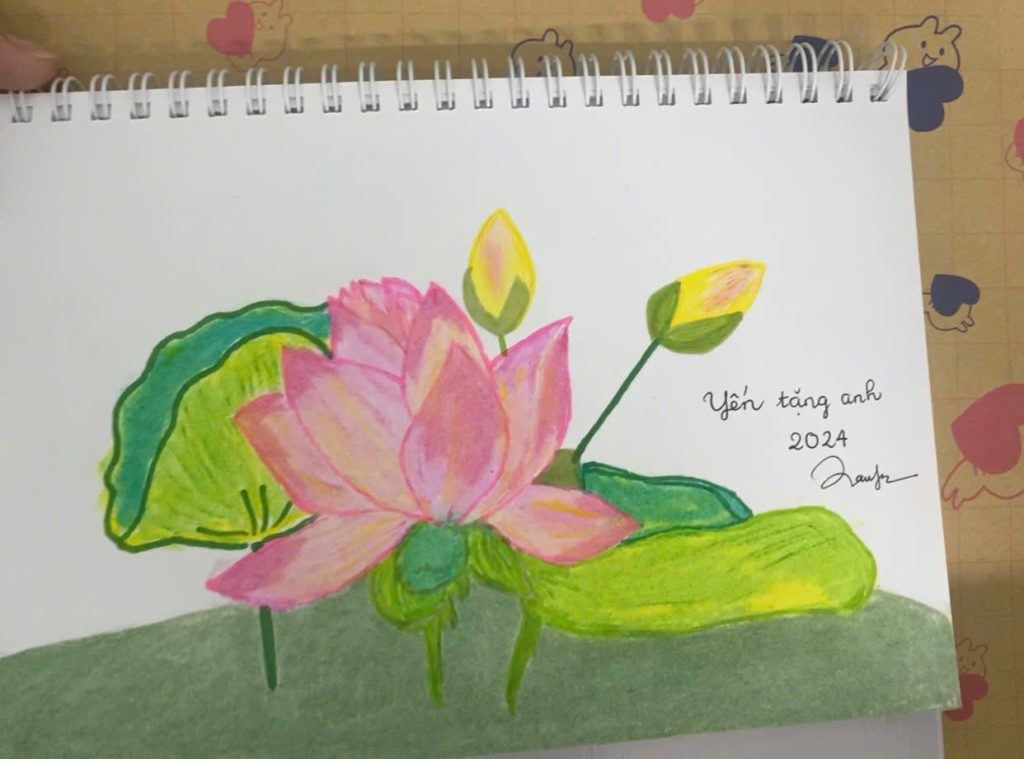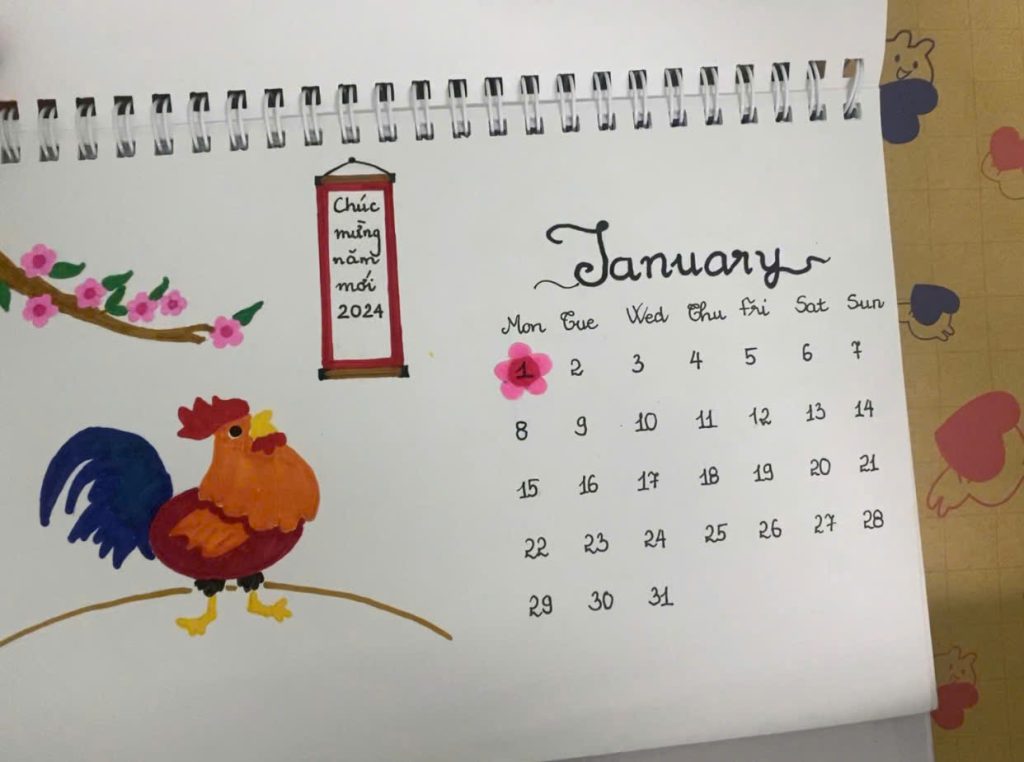Part 2: Describe something you have made yourself (from wood, metal, paper or other material)
You should say:
what you made
why you made it
how you made it
and explain how you felt about it.
Các bài mẫu trên trang web này có khá nhiều từ vựng nâng cao. Mình không phải muốn ‘nhồi nhét’ để các bạn ‘ngợp’ đâu, mà mong muốn tạo thêm nhiều cơ hội để các bạn trau dồi thêm vốn từ vựng. Nếu có phần nào cảm thấy hơi khó, các bạn cứ thoải mái đơn giản hóa lại nhé!
Các bài mẫu chỉ mang tính chất tham khảo và đều đạt tiêu chuẩn từ vựng (lexical resource) và ngữ pháp (grammatical range and accuracy) ở mức 8+. Tuy nhiên, bạn không nên học thuộc lòng mà hãy trả lời theo cách/câu chuyện của riêng mình. Đồng thời, đừng quên chú trọng vào hai tiêu chí quan trọng nhất: phát âm (pronunciation) và độ trôi chảy (fluency).
Với đề này mình sẽ nói về cuốn lịch handmade mình tặng bạn trai của mình. 😊
Bài mẫu
The handmade item I’d like to describe is a personalized calendar that I meticulously crafted for my boyfriend during the early stages of our relationship. Not only is it aesthetically pleasing and meaningful, but it also serves a practical purpose, making it a truly cherished gift.
The calendar itself is compact, as it follows an A5 size, which makes it easy to display on a desk or a shelf. It comprises 13 individual sheets of paper – one cover and twelve for each month of the year. I divided each page into two sections: on the right, I wrote the dates and months, while on the left, I hand-drew pictures and added personal decorations that I created myself, infusing each page with a unique and intimate touch.
Given that my boyfriend is Vietnamese-German and we’ve been dating for over a year, I wanted to make something special to mark our long-distance relationship. He is incredibly affable and gregarious, and we plan to tie the knot next year, so I wanted a gift that would serve as a daily reminder of our connection.
The motivation behind creating this calendar was rooted in my desire to bridge the physical distance between us. I wanted to give him something that would remind him of me every day, and a personalized calendar seemed perfect for this. The process itself was both enjoyable and rewarding. I dedicated hours to perfecting each illustration, ensuring that every page was both visually appealing and deeply meaningful. I used vibrant colors and intricate details to convey a sense of warmth and affection.
When I finally presented the calendar to him, his reaction was priceless. He was visibly moved by the amount of thought and effort I had invested in the gift. For me, seeing his genuine appreciation made the entire process worthwhile. Creating something with my own hands that had such a positive emotional impact was incredibly satisfying.


Vocabulary:
- Meticulously: (adv) /məˈtɪkjələsli/: in a way that shows great attention to detail; very thoroughly.
Vietnamese: Một cách tỉ mỉ - Practical: (adj) /ˈpræktɪkəl/: useful and sensible.
Vietnamese: Thực dụng, hữu ích - Cherished: (adj) /ˈtʃɛrɪʃt/: valued and cared for with affection.
Vietnamese: Được trân quý - Compact: (adj) /kəmˈpækt/: small and neatly arranged.
Vietnamese: Nhỏ gọn - Affable: (adj) /ˈæfəbəl/: friendly, good-natured, or easy to talk to.
Vietnamese: Dễ gần, thân thiện - Gregarious: (adj) /ɡrɪˈɡɛriəs/: sociable; enjoying the company of others.
Vietnamese: Hòa đồng - Daily reminder: (n) /ˈdeɪli rɪˈmaɪndər/: something that reminds someone of a person or event every day.
Vietnamese: Lời nhắc nhở hàng ngày - Intricate: (adj) /ˈɪntrɪkət/: very complicated or detailed.
Vietnamese: Phức tạp, tỉ mỉ - Visibly moved: (phrase) /ˈvɪzəbli muːvd/: showing emotions clearly, especially in response to something touching.
Vietnamese: Xúc động rõ ràng
Part 3:
1. Why do people enjoy making things by hand instead of buying them?
I believe many people enjoy creating things by hand because it gives them a sense of accomplishment and personalization that store-bought items simply can’t offer. When you craft something yourself, whether it’s a piece of furniture or a knitted scarf, it holds sentimental value that can’t be replicated. Additionally, the process of making something is often therapeutic, allowing individuals to express their creativity while also relieving stress. For instance, working with your hands can serve as a form of mindfulness, as it requires focus and attention to detail, keeping you engaged in the moment.
2. Do you think children should be encouraged to make things by hand?
Absolutely. Encouraging children to make things by hand fosters creativity and problem-solving skills. When kids are given the opportunity to craft something, they learn how to think critically and work through challenges. For example, building a simple model or drawing something from their imagination can help them develop fine motor skills and give them a greater sense of independence. Additionally, making things by hand nurtures a sense of achievement, as they can see the tangible result of their efforts.
3. Is it important to learn handicraft skills in today’s modern world?
In today’s digital age, learning handicraft skills may seem less crucial, but I would argue that it remains highly beneficial. Handicrafts encourage manual dexterity, creativity, and patience—qualities that are valuable in any profession or life situation. Moreover, knowing how to make something by hand allows individuals to be more self-reliant. For example, being able to sew or repair something can save both time and money, which is increasingly relevant in a consumer-driven society where people often throw things away rather than repair them. It’s also a great way to step away from screens and engage in a more tactile, rewarding experience.
4. What are the advantages and disadvantages of producing handmade products in comparison to mass-produced ones?
Handmade products are often superior in terms of uniqueness and quality. Since they’re crafted with care, attention to detail is often higher, resulting in a more durable and personalized item. Handmade goods also support local artisans and small businesses, which is beneficial for the community. However, the disadvantage is that they can be more time-consuming to produce and often cost more due to the labor-intensive nature of the process. On the other hand, mass-produced products are more affordable and accessible, but they may lack the individual touch and longevity of handmade items.
Vocabulary:
- Therapeutic: (adj) /ˌθɛrəˈpjuːtɪk/: having a good effect on the mind or body; healing.
Vietnamese: Mang tính trị liệu - Mindfulness: (n) /ˈmaɪndfʊlnɪs/: the practice of being aware of your body, mind, and feelings in the present moment.
Vietnamese: Chánh niệm - Problem-solving skills: (n) /ˈprɑːbləm ˈsɑːlvɪŋ skɪlz/: the ability to find solutions to issues or challenges.
Vietnamese: Kỹ năng giải quyết vấn đề - Manual dexterity: (n) /ˈmænjuəl dɛkˈstɛrɪti/ skill at working with one’s hands.
Vietnamese: Kỹ năng làm việc bằng tay - Self-reliant: (adj) /ˌsɛlf rɪˈlaɪənt/: able to rely on oneself for things, independent.
Vietnamese: Tự lực, tự lập - Uniqueness: (n) /juːˈniːknəs/: the quality of being one of a kind.
Vietnamese: Sự độc đáo - Artisan: (n) /ˈɑːrtɪzən/: a worker skilled in making things by hand.
Vietnamese: Thợ thủ công - Labor-intensive: (adj) /ˈleɪbər ɪnˈtɛnsɪv/: requiring a lot of work or effort.
Vietnamese: Cần nhiều lao động - Longevity: (n) /lɑːnˈʤɛvɪti/: long life or existence.
Vietnamese: Độ bền, trường tồn
